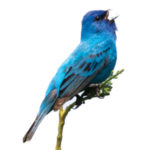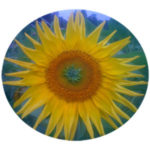WHY should we plant pollinator habitat?
Community activists to global leaders explain
“If the bee disappeared off the surface of the globe, then man would have only four years of life left. No more bees, no more pollination, no more plants, no more animals, no more man.” — Albert Einstein
~from the press~
Monarch Butterflies in Western North America in Jeopardy
Population of monarchs overwintering in California at lowest level ever recorded (January 2019, excerpt)
PORTLAND, Ore.; Thursday, 1/17/19—The population of monarch butterflies overwintering in California has fallen to the lowest level ever recorded. Surveys done by volunteers with the Western Monarch Thanksgiving Count found only 28,429 butterflies, an 85.2% fall from the previous year—and a 99.4% decline from the number of monarchs in the state in the 1980s. The results of the count were released Thursday by the Xerces Society for Invertebrate Conservation, along with a Western Monarch Call to Action.
“To picture what this means for monarchs, imagine that the population of Los Angeles had shrunk to that of the town of Monterey,” said Emma Pelton, a monarch conservation expert with the Xerces Society.
Faced with these alarming numbers, Pelton has worked with monarch scientists at institutions across the West to develop the Western Monarch Call to Action, a five-point rapid-response action plan to rescue the western population of the monarch butterfly.
The most immediate priority in the coming weeks is to ensure monarchs have nectar to fuel their flight and milkweeds on which they can lay their eggs when they leave the overwintering sites. This is something that everyone in California can help with right now: plant early blooming native flowers and milkweed to restore breeding and migratory habitat. Monarchs will use plants growing in gardens, parks, along railroads, on farms and anywhere else they can find them.
“It’s easy to give up when faced with news like this,” said Pelton. “But doing nothing is not an option.”
Media Contacts:
Emma Pelton, Endangered Species Conservation Biologist; emma.pelton@xerces.org
Sarina Jepsen, Endangered Species Program Director; sarina.jepsen@xerces.org
Our responsibility is to species, not to specimens; to communities, not to individuals.—Sara Stein, Noah’s Garden
There is a worldwide phenomenon taking place, and it affects every element of life as we know it. Globally, across the United States, and throughout Massachusetts, pollinator species are in decline. The exact causes of the decline of each of the tens of thousands of species may still be indefinite, yet much is already understood: without pollinators, human life and all terrestrial ecosystems on earth would not survive. Pollination is not just fascinating natural history: it is an essential ecological function (U.S. Forest Service).
According to the National Academy of Sciences, close to three quarters of the flowering plants on earth rely on pollinators in order to reproduce. From these plants comes one-third of humankind’s food, and even greater proportions of food for wildlife.
Great Barrington Pollinator Action Plan (Massachusetts, Winter 2018, excerpt)
—Evan Abrasion, Elan Bills, Renee Ruhl
Letter to the White House, April 2014 (excerpt)
…We recognize that ongoing reports of honey bee decline are driving much of the interest in pollinators today. However, less well known but far more alarming, is the growing body of evidence suggesting that wild bees and other pollinators are faring even worse.
For example, a recent analysis conducted by researchers from across North America now reveals that one-third of the 46 bumble bee species found in the United States are at risk of extinction. Similarly, as the White House already knows, precipitous declines of the once ubiquitous and iconic monarch butterfly represent a shocking trend as the population dwindles to record lows….While multiple and complex factors are likely driving the decline of our pollinators—including habitat alteration, pesticide use, parasites and diseases, and, perhaps, climate change—habitat restoration with native plants is a key strategy that can buffer bee populations against the multitude of threats that they face.
Scott Hoffman Black, Executive Director
The Xerces Society
Native Bees Are Effective and Efficient Pollinators
Definition: What’s the difference between honeybees and native bees?
- Honeybees are “managed”—they live in a a hive with a Queen and are tended by beekeepers. Honeybees are not native to the U.S., they were imported from Europe along with the food plants that require them.
- Native bees are just as hard working, but local. Most live singly—in tree stumps and snatches of hollow branches and in abandoned mouse holes underground. Bumblebees are an exception—these native bees do live in colonies. Most native bees have no stinger, as they have no colony to protect.
Native bees are more effective than honey bees at pollinating flowers on a bee-per-bee basis.
Only 250 female orchard mason bees (also called blue orchard bees) are required to effectively pollinate an acre of apples, a task that would need 1.5 to 2 honey bee hives—approximately 15,000 to 20,000 bees.
Many native bees, such as mason and bumble bees, will forage in colder and wetter conditions than honey bees.
Some native bees specialize in one type of flower. Squash bees, for example, visit primarily cucurbits; the females begin foraging before dawn, and males spend the night in the flowers, resulting in efficient pollination and larger fruits.
Unlike honey bees, bumble bees and other native bees perform buzz pollination (the bee grabs onto a flower’s stamens and vibrates its flight muscles, releasing a burst of pollen from deep pores in the anther). This behavior is highly beneficial for the cross-pollination of tomatoes, peppers, cranberries, and blueberries, among other plants. Although tomatoes don’t require a pollinator to set fruit, buzz pollination by bees results in larger and more abundant fruit.
The Xerces Society for Invertebrate Conservation — xerces.com
Farming with Pollinators: Increasing Profit and Reducing Risk (2014, exerpt)



